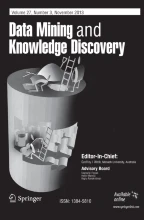Abstract
k-Anonymity is a useful concept to solve the tension between data utility and respondent privacy in individual data (microdata) protection. However, the generalization and suppression approach proposed in the literature to achieve k-anonymity is not equally suited for all types of attributes: (i) generalization/suppression is one of the few possibilities for nominal categorical attributes; (ii) it is just one possibility for ordinal categorical attributes which does not always preserve ordinality; (iii) and it is completely unsuitable for continuous attributes, as it causes them to lose their numerical meaning. Since attributes leading to disclosure (and thus needing k-anonymization) may be nominal, ordinal and also continuous, it is important to devise k-anonymization procedures which preserve the semantics of each attribute type as much as possible. We propose in this paper to use categorical microaggregation as an alternative to generalization/suppression for nominal and ordinal k-anonymization; we also propose continuous microaggregation as the method for continuous k-anonymization.
Similar content being viewed by others
Explore related subjects
Discover the latest articles, news and stories from top researchers in related subjects.References
Aggarwal, G., Feder, T., Kenthapadi, K., Motwani, R., Panigrahy, R., Thomas, D., and Zhu, A. 2004. k-Anonymity: Algorithms and hardness. Technical report, Stanford University.
Dalenius, T. 1986. Finding a needle in a haystack - or identifying anonymous census records. Journal of Official Statistics, 2(3):329–336.
Defays, D. and Nanopoulos, P. 1993. Panels of enterprises and confidentiality: the small aggregates method. In Proc. of 92 Symposium on Design and Analysis of Longitudinal Surveys. Ottawa, Statistics Canada, pp.195–204.
Domingo-Ferrer, J. and Mateo-Sanz, J.M. 2002. Practical data-oriented microaggregation for statistical disclosure control. IEEE Transactions on Knowledge and Data Engineering, 14(1):189–201.
Domingo-Ferrer, J., Mateo-Sanz, J.M., and Torra, V. 2001. Comparing sdc methods for microdata on the basis of information loss and disclosure risk. In Pre-proceedings of ETK-NTTS'2001 (vol. 2). Luxemburg. Eurostat, pp. 807–826.
Domingo-Ferrer, J. and Torra, V. 2001a. Disclosure protection methods and information loss for microdata. In P. Doyle, J.I. Lane, J.J.M. Theeuwes, and L. Zayatz (Eds.), Confidentiality, Disclosure and Data Access: Theory and Practical Applications for Statistical Agencies, Amsterdam. North-Holland. http://vneumann.etse.urv.es/publications/bcpi pp. 91–110.
Domingo-Ferrer, J. and Torra, V. 2001b. A quantitative comparison of disclosure control methods for microdata. In P. Doyle, J.I. Lane, J.J.M. Theeuwes, and L. Zayatz (Eds.), Confidentiality, Disclosure and Data Access: Theory and Practical Applications for Statistical Agencies, Amsterdam. North-Holland. http://vneumann.etse.urv.es/publications/bcpi, pp. 111–134.
Domingo-Ferrer, J. and Torra, V. 2005. Privacy in statistical databases: Methods and performance metrics for microdata protection. manuscript.
Duncan, G.T., Fienberg, S.E., Krishnan, R., Padman, R., and Roehrig, S.F. 2001a. Disclosure limitation methods and information loss for tabular data. In P. Doyle, J.I. Lane, J.J. Theeuwes and L.V. Zayatz (Eds.), Confidentiality, Disclosure and Data Access: Theory and Practical Applications for Statistical Agencies. Amsterdam. North-Holland, pp. 135–166.
Duncan, G.T., Keller-McNulty, S.A., and Stokes, S.L. 2001b. Disclosure risk vs. data utility: The r-u confidentiality map.
Hundepool, A., de Wetering, A.V., Ramaswamy, R., Franconi, L., Capobianchi, A., DeWolf, P.-P., Domingo-Ferrer, J., Torra, V., Brand, R., and Giessing, S. 2003. μ-ARGUS version 3.2 Software and User's Manual. Statistics Netherlands, Voorburg NL. http://neon.vb.cbs.nl/casc://neon.vb.cbs.nl/casc.
Mateo-Sanz, J.M., Domingo-Ferrer, J., and Sebé, F. 2005. Probabilistic information loss measures in confidentiality protection of continuous microdata. Data Mining and Knowledge Discovery, this issue.
Meyerson, A. and Williams, R. 2004. On the complexity of optimal k-Anonymity. In Proc. of the ACM Symposium on Principles of Database Systems-PODS'2004. Paris, France. ACM, pp. 223–228.
Oganian, A. and Domingo-Ferrer, J. 2001. On the complexity of optimal microaggregation for statistical disclosure control. Statistical Journal of the United Nations Economic Comission for Europe, 18(4):345–354.
Reiter, J.P. 2004. Releasing multiply-imputed, synthetic public use microdata: An illustration and empirical study. Journal of the Royal Statistical Society, Series A, page forthcoming.
Samarati, P. 2001. Protecting respondents' identities in microdata release. IEEE Transactions on Knowledge and Data Engineering, 13(6):1010–1027.
Samarati, P. and Sweeney, L. 1998. Protecting privacy when disclosing information: k-anonymity and its enforcement through generalization and suppression. Technical report, SRI International.
Sebé, F., Domingo-Ferrer, J., Mateo-Sanz, J.M., and Torra, V. 2002. Post-masking optimization of the tradeoff between information loss and disclosure risk in masked microdata sets. In J. Domingo-Ferrer (ed.), Inference Control in Statistical Databases, volume 2316 of LNCS, Berlin Heidelberg, Springer, pp. 163–171.
Sweeney, L. 2002a. Achieving k-anonymity privacy protection using generalization and suppression. International Journal of Uncertainty, Fuzziness and Knowledge Based Systems, 10(5):571–588.
Sweeney, L. 2002b. k-anonimity: A model for protecting privacy. International Journal of Uncertainty, Fuzziness and Knowledge Based Systems, 10(5):557–570.
Torra, V. 2004. Microaggregation for categorical variables: A median based approach. In J. Domingo-Ferrer and V. Torra (Eds.), Privacy in Statistical Databases, volume 3050 of LNCS, Berlin Heidelberg. Springer, pp. 162–174.
Willenborg, L. and DeWaal, T. 2001. Elements of Statistical Disclosure Control. Springer-Verlag, New York.
Winkler, W. E. 2004. Re-identification methods for masked microdata. In J. Domingo-Ferrer and V. Torra (Eds.), Privacy in Statistical Databases, volume 3050 of LNCS, Berlin Heidelberg, Springer, pp. 216–230.
Yancey, W.E., Winkler, W.E., and Creecy, R.H. 2002. Disclosure risk assessment in perturbative microdata protection. In J. Domingo-Ferrer (Eds.), Inference Control in Statistical Databases, volume 2316 of LNCS, Berlin Heidelberg. Springer, pp. 135–152.
Acknowledgments
Francesc Sebé's help in obtaining the results reported for continuous data is gratefully acknowledged. Comments by William Winkler were also particularly useful to improve this paper. This work was partly funded by the Spanish Ministry of Science and Technology and the European FEDER Fund under project TIC2001-0633-C03-01/03 “STREAMOBILE” and also by the Spanish Ministry of Education and Science under project SEG2004-04352-C04-01/02 “PROPRIETAS”.
Author information
Authors and Affiliations
Corresponding author
Additional information
Editor:
Geoff Webb
Rights and permissions
About this article
Cite this article
Domingo-Ferrer, J., Torra, V. Ordinal, Continuous and Heterogeneous k-Anonymity Through Microaggregation. Data Min Knowl Disc 11, 195–212 (2005). https://doi.org/10.1007/s10618-005-0007-5
Received:
Accepted:
Published:
Issue Date:
DOI: https://doi.org/10.1007/s10618-005-0007-5
